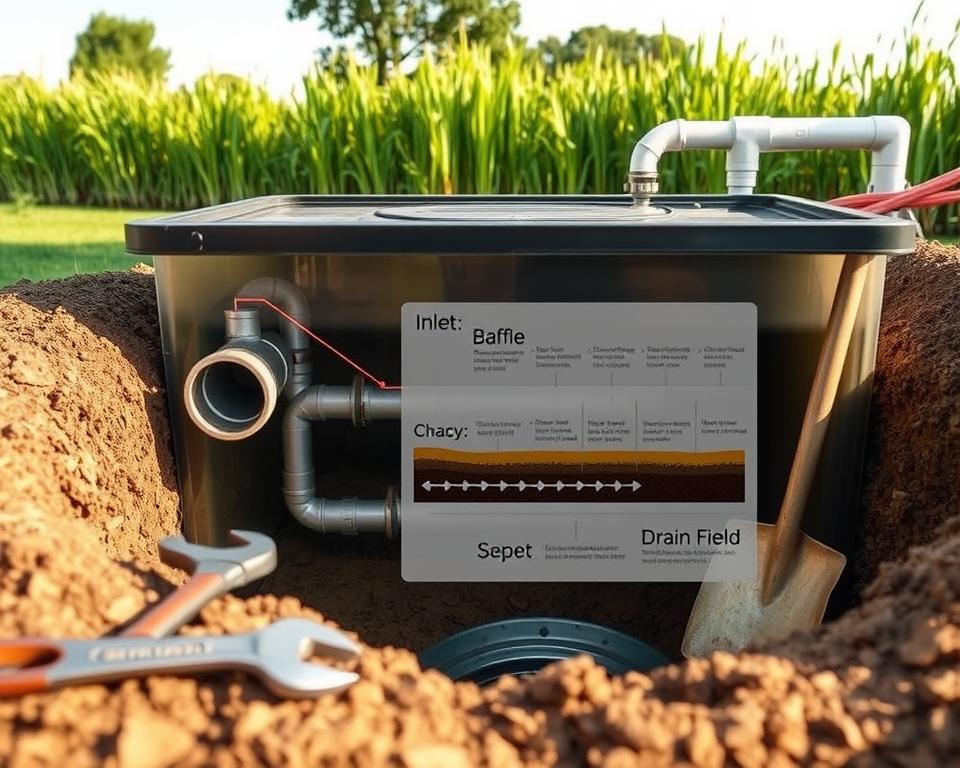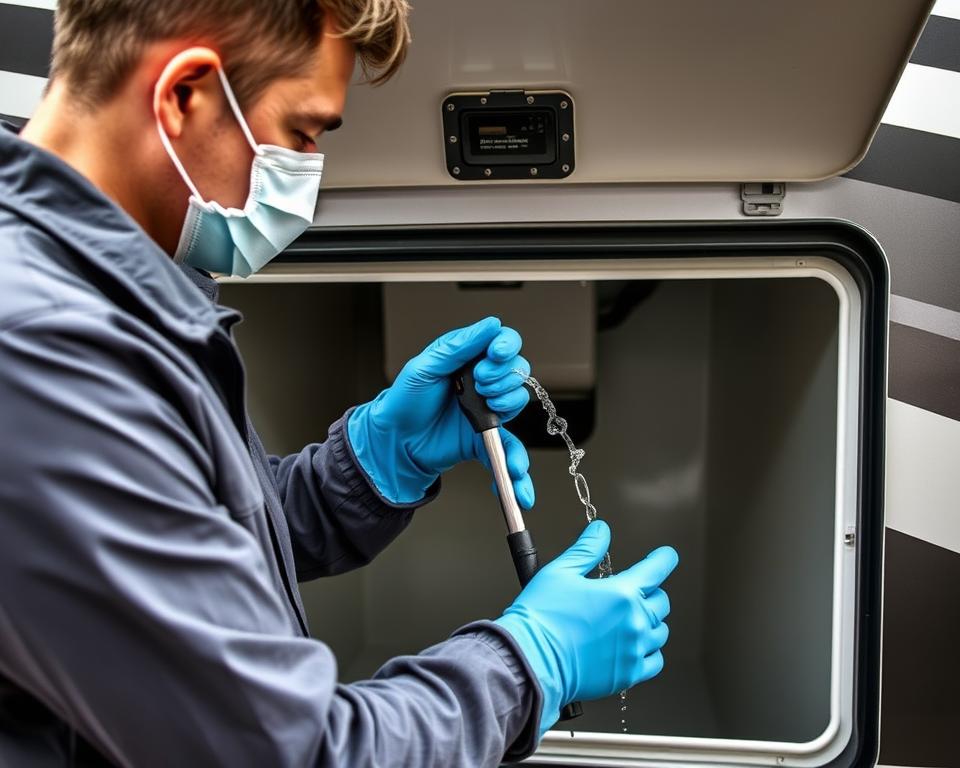Aerobic Tank Air Pump: Comprehensive Guide for Residential Users
Ever pondered on what enhances your oxygen-based Septic system’s efficiency? The aeration device is the little-known hero crucial for your system. Throughout this overview, you will acquire essential knowledge on the air Pump’s purpose. It’s critical for a sound, optimized Septic tank.
Knowing the value of a Septic tank air Pump can boost your Septic system’s capabilities using septic tank pump replacement. It also preserves your asset value and ecological well-being. Our handbook will feature All in Sanitation, a reputable Septic industry authority. They’re prepared to serve your Septic aerator Pump requests.
Highlight Reel
- The Septic air Pump is paramount for oxygen-based Septic setups.
- Looking after your Septic system air Pump can optimize overall system efficiency.
- Scheduled assessments prolong the durability of your Septic tank air Pump.
- Picking the best-fit Septic aerator Pump is essential for peak operation.
- All in Sanitation offers specialized services for Septic air Pump requirements.
Exploring Aerobic Septic Systems
Aerobic Septic systems present a superior waste treatment method by employing oxygen. This technique consists of aerobic bacteria operating in well-oxygenated environments. These bacteria are faster in processing organic matter. With the help of Septic aerator Pumps, these systems ensure a consistent oxygen supply, accelerating the waste decomposition process.
These systems perform well in lowering sludge buildup, owing to the efficiency of aerobic bacteria. This drop in solid waste means less maintenance and periodic Pump service is necessary. Additionally, they efficiently treat wastewater, resulting in minimal smells. This produces a more pleasant environment for homeowners and the community overall.
To confirm these systems run successfully, it’s crucial to understand the key Septic system components. These include the Septic tank, treatment chamber, and effluent Pump. Each element serves a key function, especially the air Pump. It pushes oxygen into the tank, crucial for the aerobic bacteria’s performance.
Importance of the Septic Air Pump
The Septic air Pump is crucial in the performance of aerobic Septic systems. It acts as the system’s “oxygen source,” providing the vital oxygen needed. This oxygen enables aerobic bacteria to operate efficiently and digest waste properly. If the Pump malfunctions, the system’s efficiency declines, bringing about sludge collection and possible odors.
Such issues can undermine Septic system operations and create environmental hazards. By understanding how essential the Septic air Pump is, homeowners can move early. They can ensure its optimal function through scheduled service. This avoids failures, reduces costly repairs, and keeps the aerobic system’s condition.
Major Benefits of Using a Septic Air Pump
Employing a Septic air Pump markedly increases the efficiency of Septic systems. Septic air Pumps are essential as they speed up the breakdown of waste. This is done by oxygenating the treatment process, stimulating aerobic bacteria growth. These bacteria are vital for proper waste treatment.
They’re also useful in lowering foul smells. Because of more active aerobic processes, waste decomposes faster, thus reducing odors. This creates a nicer atmosphere for homeowners.
Another noteworthy benefit is the drop in sludge accumulation. Consequently, tanks demand less frequent Pumping, cutting both money and time. Better processing not only reduces spending but also lengthens the lifespan of the drain field.
Looking after these Pumps properly means less frequent repair costs and adhering to regulatory standards. Thus, the pluses of Septic air Pumps extend past for homeowners. They also enhance environmental health by raising waste management practices.
| Benefit |
Description |
| Fast Waste Breakdown |
Heightened aerobic activity speeds the decomposition process. |
| Minimized Odor Emissions |
Improved treatment efficacy leads to fewer odors. |
| Reduced Sludge Buildup |
Less frequent Pumping and maintenance are needed. |
| Extended Drain Field Life |
Better treatment ensures a healthier drain field. |
| Cost Savings |
Lower probability of repairs and regulatory compliance cost. |

Selecting the Best Septic Air Pump
Selecting the right Septic air Pump is critical for an well-running aerobic system. Homeowners should assess various factors for the perfect selection. The size of the tank and the airflow needs play a crucial role the Pump’s output.
To select well, it’s essential to know the air Pumps available. There are mainly two types: linear diaphragm Pumps and rotary vane Pumps. Each comes with particular pluses, which should be aligned with your home’s individual circumstances and usage pattern.
Energy efficiency also is a factor. Choosing a Pump that lowers energy use while achieving the needed airflow can offer noticeable cost cuts. Assistance from All in Sanitation specialists can be extremely useful. They confirm the Pump you choose fits your system’s requirements perfectly.
Common Types of Septic Air Pumps
Homeowners can make better choices by knowing the distinct Septic air Pumps available. There are mainly two types: diaphragm Pumps and rotary vane Pumps. Each has its unique functions and benefits.
Diaphragm Pumps, famous for their low-noise operation, are preferred for residential Septic systems. They provide energy efficiency while ensuring stable air output. Their reliable performance suits smaller systems, meeting the needs of many homeowners.
Rotary vane Pumps, however, are better suited for bigger or commercial systems. These Pumps offer greater output, essential in handling bigger loads. Their durable build guarantees efficient operation in extensive Septic systems.
| Type of Pump |
Best Use |
Advantages |
| Diaphragm Pumps |
Residential Systems |
Quiet operation, energy-efficient, reliable air flow |
| Rotary Vane Pumps |
Larger or Commercial Systems |
Powerful performance, high capacity, durable construction |
Recognizing the distinctions in Septic air Pumps is essential for upgrades or replacements. Each Pump type offers specific features to address various needs. This guarantees best performance for any system.
Clues Pointing to a Septic Air Pump Replacement
Homeowners must watch for Pump failure signs in their Septic systems. Some signals suggest the need for a Septic air Pump replacement. These ensure continued performance. Catching these early prevents larger issues.
Signs of potential problems include:
- Unusual noises from the Pump, like clanking or shaking, might suggest internal damage.
- A clear lack of air output means the Pump isn’t working well, impacting efficiency.
- Regular electrical problems, such as tripped breakers or flickering lights, could show overloading.
- Visible damage on the Pump unit, with breaks or leaks, needs quick action.
- Foul odors in the yard often reveal a compromised Pump, showing ineffective effluent aeration.
Spotting these signs early prevents high repair bills or total system failure. Performing periodic reviews makes it easy to catch these issues. It also clarifies if you ought to have a new Septic air Pump.
Maintenance Tips for Your Septic Air Pump
For an optimal Septic air Pump, consistent service is essential. This ensures that that your system functions properly. Homeowners can use several practical care strategies for best results.
Half-yearly, run a thorough inspection for wear or damage. It is also important to swap out the filters as advised. This stops clogs that could lower efficiency.
The Pump should stand on a steady base to cut vibrations, which could damage it over time. A protective cover is vital too. It defends against debris and water, maintaining the Pump’s functionality.
Regular servicing can significantly extend the life of your Pump. In turn, this helps the Septic system’s performance overall.
| Maintenance Task |
Frequency |
Benefits |
| Inspect Pump for damage |
Every 6 months |
Identifies issues early |
| Replace filters |
As needed |
Keeps performance up |
| Check surface stability |
Annually |
Protects components |
| Clear debris around Pump |
Monthly |
Maintains airflow |
Setting Up Your Septic Air Pump
Correct installation of your Septic air Pump is essential for its smooth operation. At the outset, pick a secure, moisture-free area for placement. The chosen spot should safely accommodate the Pump’s weight without issue.
To properly fit your Pump on your own, observe the following guidelines:
- Prepare all necessary items, including the Pump, a power source, and hose fittings.
- Carefully read the manufacturer’s guidelines before starting your installation.
- Ensure every connection is tight to prevent air leaks that impact performance.
- After assembly, perform a test to ensure the system works as intended.
If the installation process feels tricky, reach out to All in Sanitation. Their professionals can prevent common errors, confirming your setup follows necessary safety requirements.
Why Choose All in Sanitation for Your Septic Air Pump Requirements
When deciding on a Septic service provider, the choice is crucial. All in Sanitation differentiates itself by delivering dependable Septic air Pumps. They address different homeowner requirements with a broad selection of premium products. This ensures customers secure an exact match for their Septic systems.
What clearly distinguishes All in Sanitation is in addition to their extensive product lineup. Their focus to superior customer service is also critical. Homeowners receive knowledgeable support, helping them choose trusted Septic solutions. This partnership is crucial to adapt each solution to meet specific needs.
All in Sanitation also emphasizes aftercare to deliver lasting satisfaction. Their promise continues beyond the initial sale. They offer ongoing support to preserve Septic systems functioning optimally for the long term.
Cost Considerations for Septic Air Pumps
Grasping the costs connected with Septic air Pumps is essential for homeowners with aerobic Septic systems. Up front, one faces the buy-in cost, which includes the Pump and associated accessories. Installation expenses vary, based on the system’s complexity and any alterations required.
Ongoing upkeep forms an additional cost layer. Consistent assessments can fend off bigger issues, in the long run yielding savings. Homeowners should plan for Septic maintenance to preserve the Pump’s effectiveness and life expectancy. Such planning sidesteps expensive repairs later on, demonstrating the value of proactive maintenance.
| Cost Component |
Average Cost Range |
| Septic Air Pump |
$500 – $1,200 |
| Installation |
$300 – $800 |
| Annual Maintenance |
$150 – $400 |
| Potential Repair Costs |
$1,000 – $5,000 |
Itemizing Septic air Pump expenses into distinct parts helps homeowners in cost forecasting. This comprehensive approach ensures the system’s reliable running and their comfort.
Conclusion
For homeowners with aerobic Septic systems, maintaining Septic tanks is vital. The right Septic air Pump improves waste processing and lengthens your system’s life. Sticking with routine maintenance and quickly fixing issues avoids expensive repairs and disruptions.
Selecting a Septic air Pump demands deliberation. This guide outlined how to choose wisely about installation and replacement. With All in Sanitation’s expertise, you can tackle your Septic systems’ complexities assuredly.
Maintaining your Septic air Pump promotes your system’s performance and durability. It provides a trouble-free and proper operation over time. Keep in mind, your home’s wastewater management relies heavily on proper care.


